Effects of Bucket Type and Angle on Downstream Nappe Wind Caused by a Turbulent Jet
Abstract
1. Introduction
2. Experimental Setup
2.1. Experimental Method
2.2. Test Conditions
3. Results and Analysis
3.1. Hydraulic Characteristics of the Trajectory Nappe
3.2. Effects of Bucket Shapes on Wind Velocity
3.2.1. Horizontal Distribution
3.2.2. Vertical Distribution
3.3. Effects of Bucket Angles on Wind Velocity
3.3.1. Horizontal Distribution
3.3.2. Vertical Distribution
3.4. Splash Characteristics
3.4.1. Effects of Bucket Shape
3.4.2. Effects of Bucket Angles
4. Conclusions
Author Contributions
Funding
Conflicts of Interest
References
- Bartle, A. Hydropower potential and development activities. Energy Policy 2002, 30, 1231–1239. [Google Scholar] [CrossRef]
- Sternberg, R. Hydropower’s future, the environment, and global electricity systems. Renew. Sustain. Energy Rev. 2010, 14, 713–723. [Google Scholar] [CrossRef]
- Khatsuria, R.M. Hydraulics of Spillways and Energy Dissipators; Dekker: New York, NY, USA, 2005. [Google Scholar]
- Lian, J.J.; Wang, X.Q.; Zhang, W.J.; Ma, B.; Liu, D. Multi-Source Generation Mechanisms for Low Frequency Noise Induced by Flood Discharge and Energy Dissipation from a High Dam with a Ski-Jump Type Spillway. Int. J. Environ. Res. Public Health 2017, 14, 1482. [Google Scholar] [CrossRef]
- Fraser, C.N. Ski-Jump Energy Dissipation: Design of a Ski-Jump to Maximize Energy Dissipation and Aeration. Master’s Thesis, Stellenbosch University, Stellenbosch, South Africa, 2016. [Google Scholar]
- Lian, J.J.; Li, C.Y.; Liu, F.; Wu, S. A prediction method of flood discharge atomization for high dams. J. Hydraul. Res. 2014, 52, 274–282. [Google Scholar] [CrossRef]
- Duan, H.D.; Liu, S.H.; Luo, Q.S.; Huang, W. Rain intensity distribution in the splash region of atomized flow. J. Hydrodyn. Ser. B 2006, 18, 362–366. [Google Scholar] [CrossRef]
- Su, J.M.; Li, H.R. The effects of atomization by flood discharge on downstream slope of Ertan hydroelectric station. Hydrogeol. Eng. Geol. 2002, 29, 22–24. (In Chinese) [Google Scholar]
- Liu, H.T.; Sun, S.K.; Liu, Z.P.; Wang, X.S. Atomization prediction based on artificial neural networks for flood releasing of high dams. J. Hydraul. Eng. 2005, 36, 1241–1245. (In Chinese) [Google Scholar]
- Liu, H.T.; Liu, Z.P.; Xia, Q.F.; Su, S.K. Computational model of flood discharge splash in large hydropower stations. J. Hydraul. Res. 2015, 53, 576–587. [Google Scholar] [CrossRef]
- Lian, J.J.; He, J.L.; Liu, F.; Ran, D.J.; Wang, X.Q.; Wang, C. An Improved Empirical Model for Flood Discharge Atomization and Its Application to Optimize the Flip Bucket of the Nazixia Project. Int. J. Environ. Res. Public Health 2019, 16, 316. [Google Scholar] [CrossRef]
- Lian, J.J.; Liu, F.; Huang, C.Y. Numerical study on effects of environmental wind and terrain on spray caused by jet from flip bucket. J. Hydraul. Eng. 2005, 36, 1147–1152. (In Chinese) [Google Scholar] [CrossRef]
- Schmocker, L.; Pfister, M.; Hager, W.H.; Minor, H.E. Aeration Characteristics of Ski Jump Jets. J. Hydraul. Eng. 2008, 134, 90–97. [Google Scholar] [CrossRef]
- Heller, V.; Hager, W.H.; Minor, H.E. Ski jump hydraulics. J. Hydraul. Eng. 2005, 131, 347–355. [Google Scholar] [CrossRef]
- Zhu, Y.Q.; Zhang, F.X.; Xu, W.L. Research on Hydraulic Characteristics of Flip Bucket with Tongue-type. Sci. Technol. Eng. 2004, 4, 397–403. (In Chinese) [Google Scholar] [CrossRef]
- Wahl, T.L.; Frizell, K.H.; Cohen, E.A. Computing the Trajectory of Free Jets. J. Hydraul. Eng. 2008, 134, 256–260. [Google Scholar] [CrossRef]
- Wu, J.H.; Li, S.F.; Ma, F. Energy dissipation of slot-type flip buckets. J. Hydrodyn. B 2018, 30, 365–368. [Google Scholar] [CrossRef]
- Pfister, M.; Hager, W.H. Deflector-jets affected by pre-aerated approach flow. J. Hydraul. Res. 2012, 50, 181–191. [Google Scholar] [CrossRef]
- Azmathullah, H.M.; Deo, M.C.; Deolalikar, P.B. Neural networks for estimation of scour downstream of a ski-jump bucket. J. Hydraul. Eng. 2005, 131, 898–908. [Google Scholar] [CrossRef]
- Pfister, M.; Hager, W.H.; Boes, R.M. Trajectories and air flow features of ski jump-generated jets. J. Hydraul. Res. 2014, 52, 336–346. [Google Scholar] [CrossRef]
- Wu, J.H.; Yao, L.; Ma, F.; Wu, W.W. Hydraulics of a multiple slit-type energy dissipater. J. Hydrodyn. 2014, 26, 86–93. [Google Scholar] [CrossRef]
- Huang, G.B.; Hu, H.; Wang, C.H.; Du, L. Shock waves and water wing in slit-type energy dissipaters. J. Hydrodyn. 2017, 29, 504–509. [Google Scholar] [CrossRef]
- Zhang, X.D. Study on Droplet Spectrum and Wind Field of Flood Discharge Atomization. Master’s Thesis, Tianjin University, Tianjin, China, 2009. (In Chinese). [Google Scholar]
- Hu, W.P.; Sven, E.; Zhang, F.B. A vertical-compressed three-dimensional ecological model in Lake Taihu, China. Ecol. Model. 2006, 190, 367–398. [Google Scholar] [CrossRef]
- Zhang, Z.F.; Li, J.C. Experimental Studies on Wind-Wave Momentum Transfer. Acta Aerodyn. Sin. 1999, 17, 285–291. (In Chinese) [Google Scholar] [CrossRef]
- Zhou, J.; Zeng, C.; Wang, L.L. Influence of wind drag coefficient on wind-driven flow simulation. J. Hydrodyn. Ser. A 2009, 24, 440–447. (In Chinese) [Google Scholar] [CrossRef]
- Li, M.; Jiang, W.M.; Zhang, N.; Liu, H.L. The numerical simulation analysis of nappe-wind generated by flood discharge. Acta Aerodyn. Sin. 2003, 4, 4. (In Chinese) [Google Scholar]
- Sha, H.F.; Zhou, H.; Wu, S.Q.; Chen, H.L. 2-D Numerical simulation of two-Phase flow from surface outlet into plunge pool. J. Hydrodyn. Ser. A 2007, 3, 8. (In Chinese) [Google Scholar]
- Zhu, Y.Q.; Xu, W.L.; Zhang, F.X. The Method to Calculate the Transversal Diffusion Width of the Nappe of Flip Bucket with Tongue-type. In Proceedings of the Symposium on Hydraulics, Chongqing, China, 18 December 2004; pp. 96–101. (In Chinese). [Google Scholar]
- Akrami, S.A.; El-Shafie, A.; Naseri, M.; Santos, C.A.G. Rainfall data analyzing using moving average (MA) model and wavelet multi-resolution intelligent model for noise evaluation to improve the forecasting accuracy. Neural Comput. Appl. 2014, 25, 1853–1861. [Google Scholar] [CrossRef]
- Liu, H.T.; Sun, S.K.; Wang, X.S.; Xia, Q.F. Study on the distribution of splashing intensity during nappe impingement. J. Hydrodyn. 2009, 24, 217–223. (In Chinese) [Google Scholar]


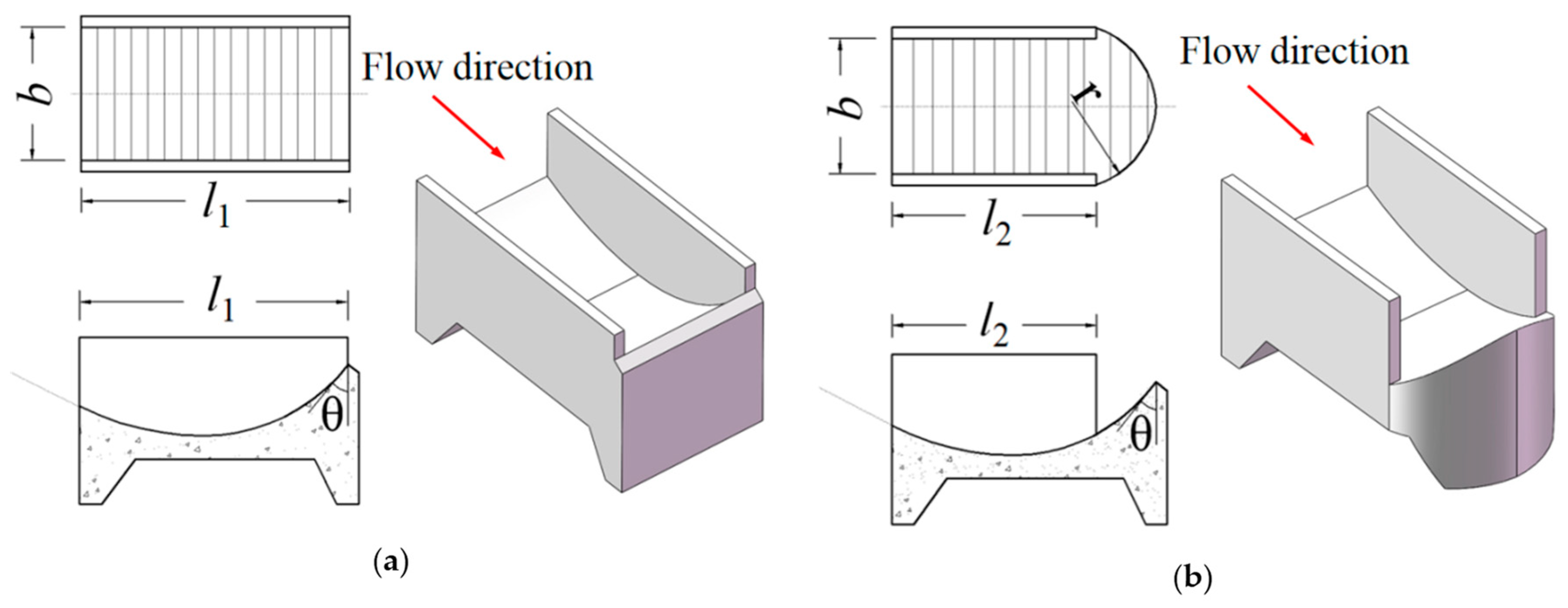
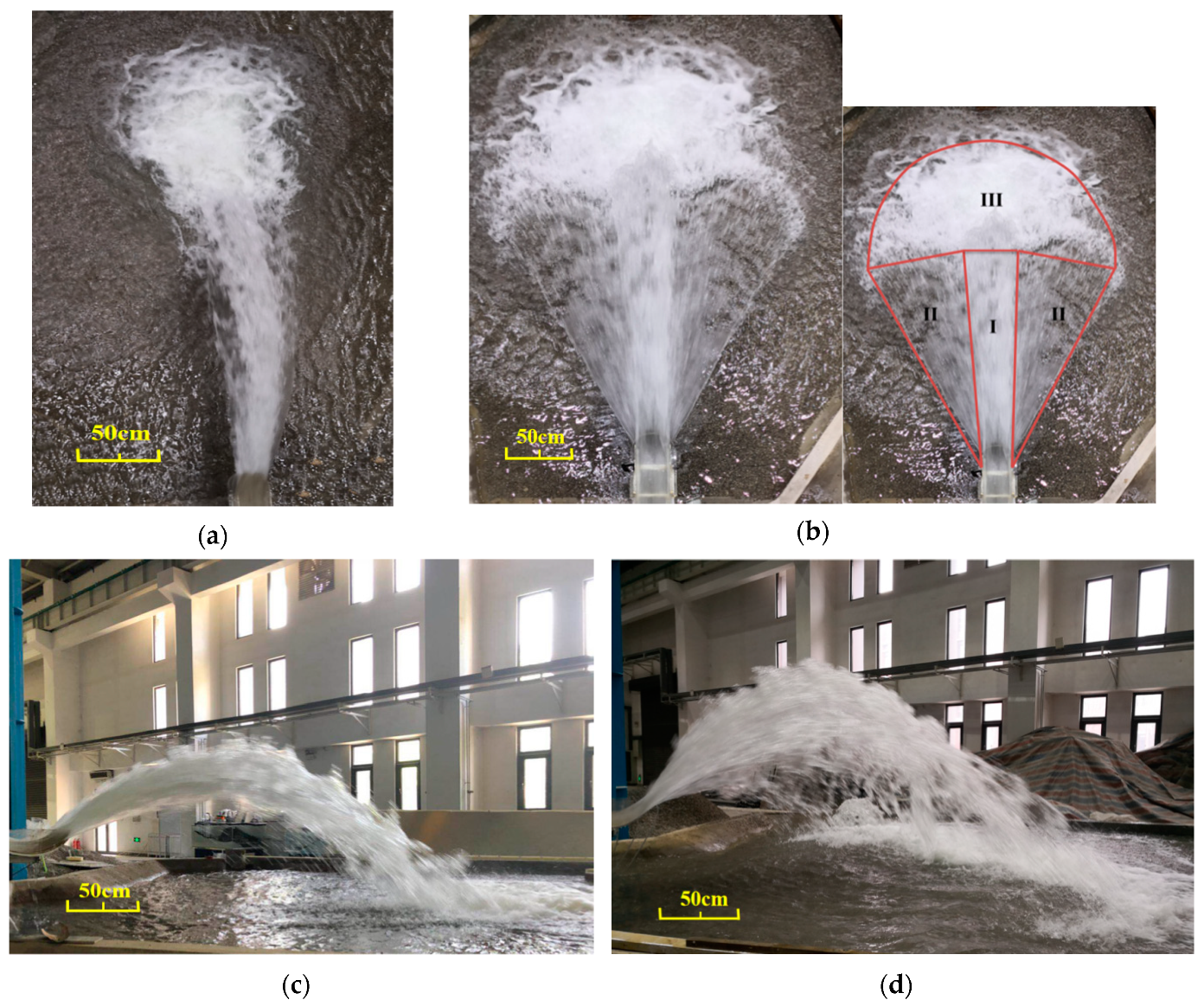
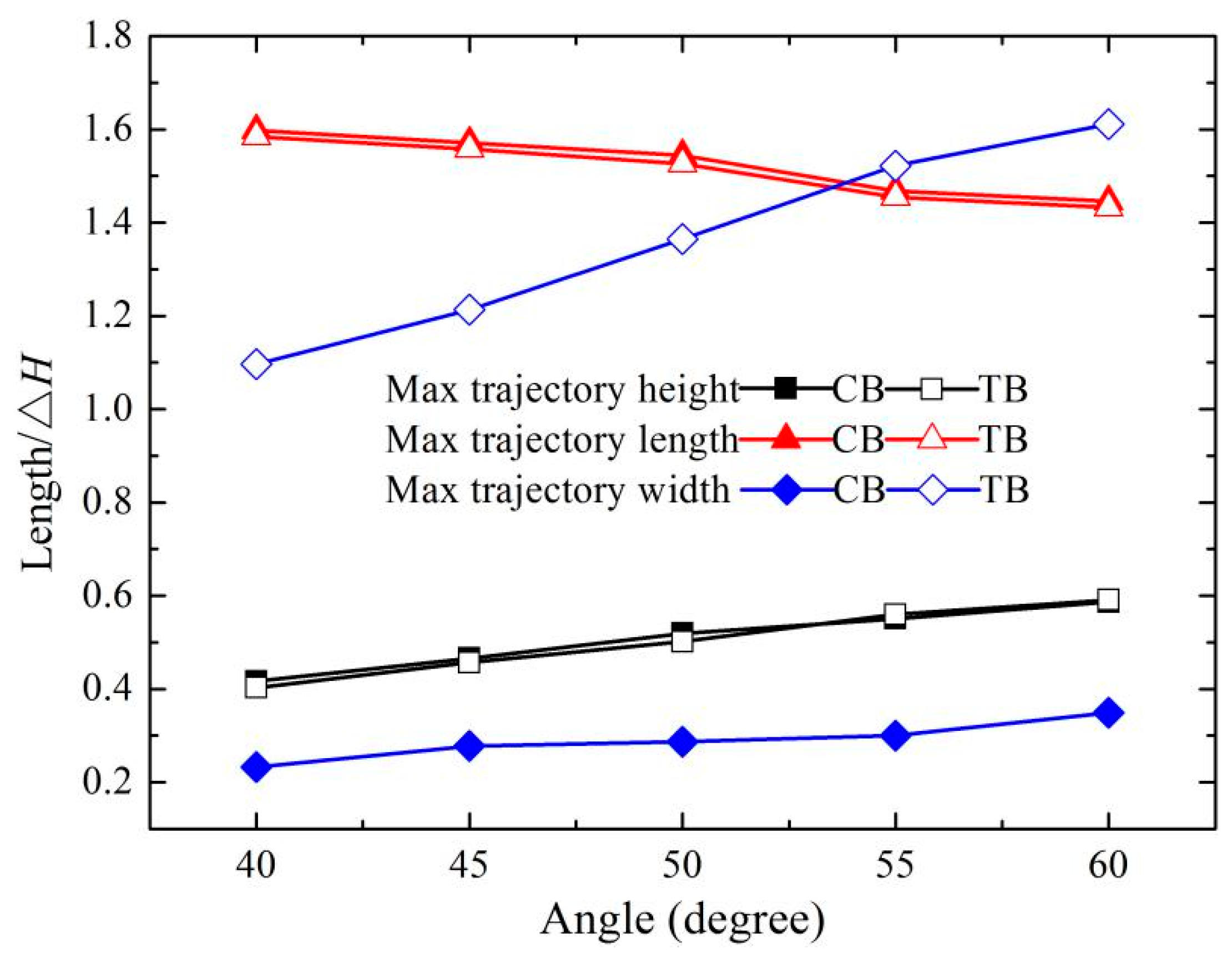


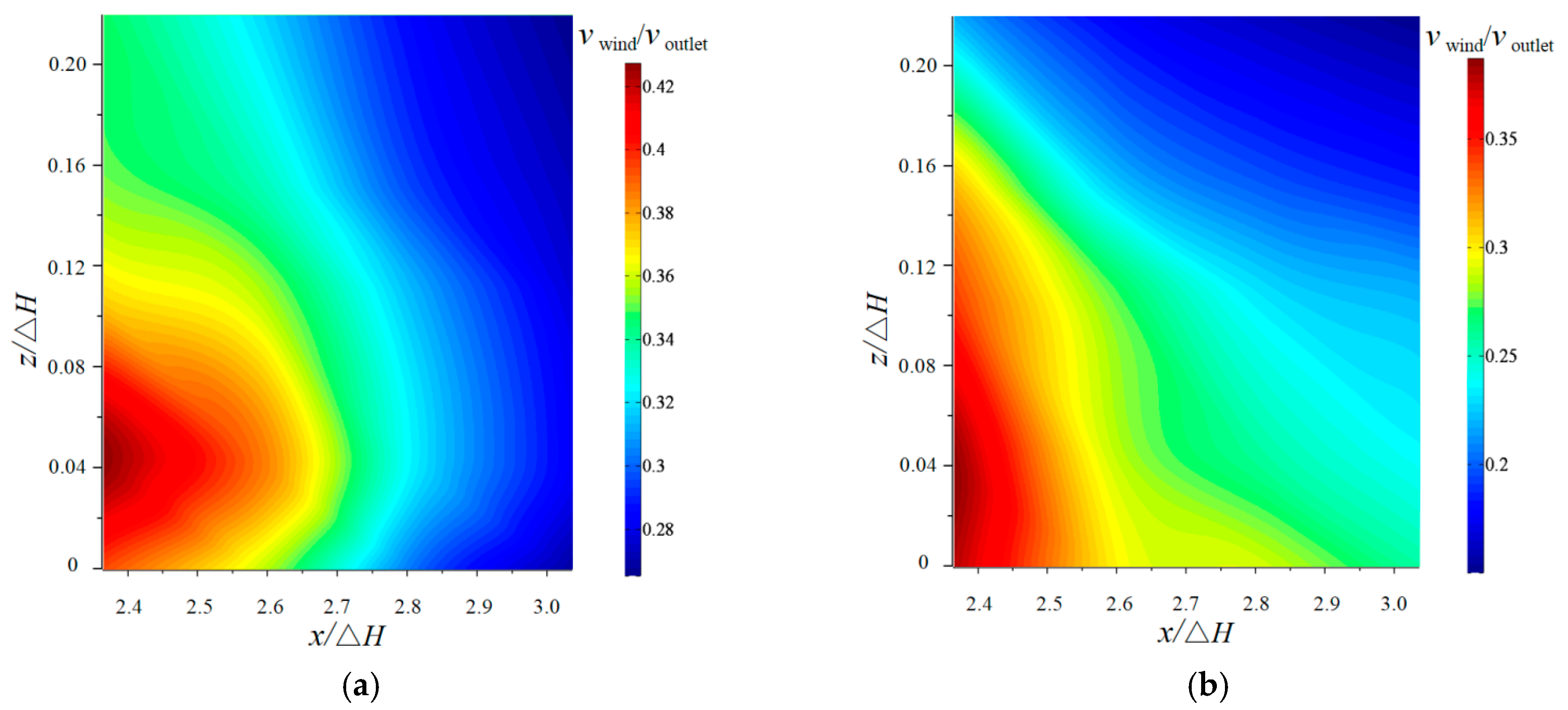
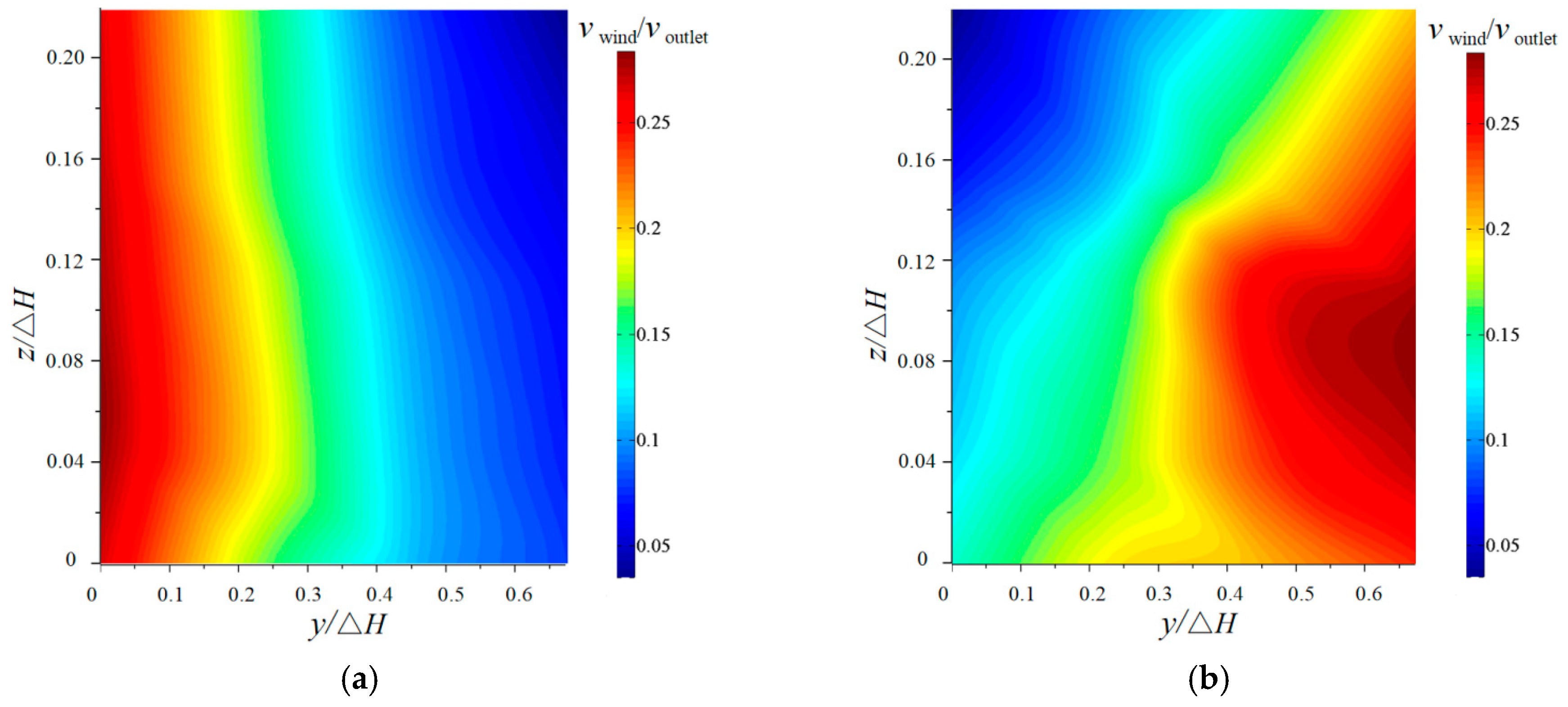
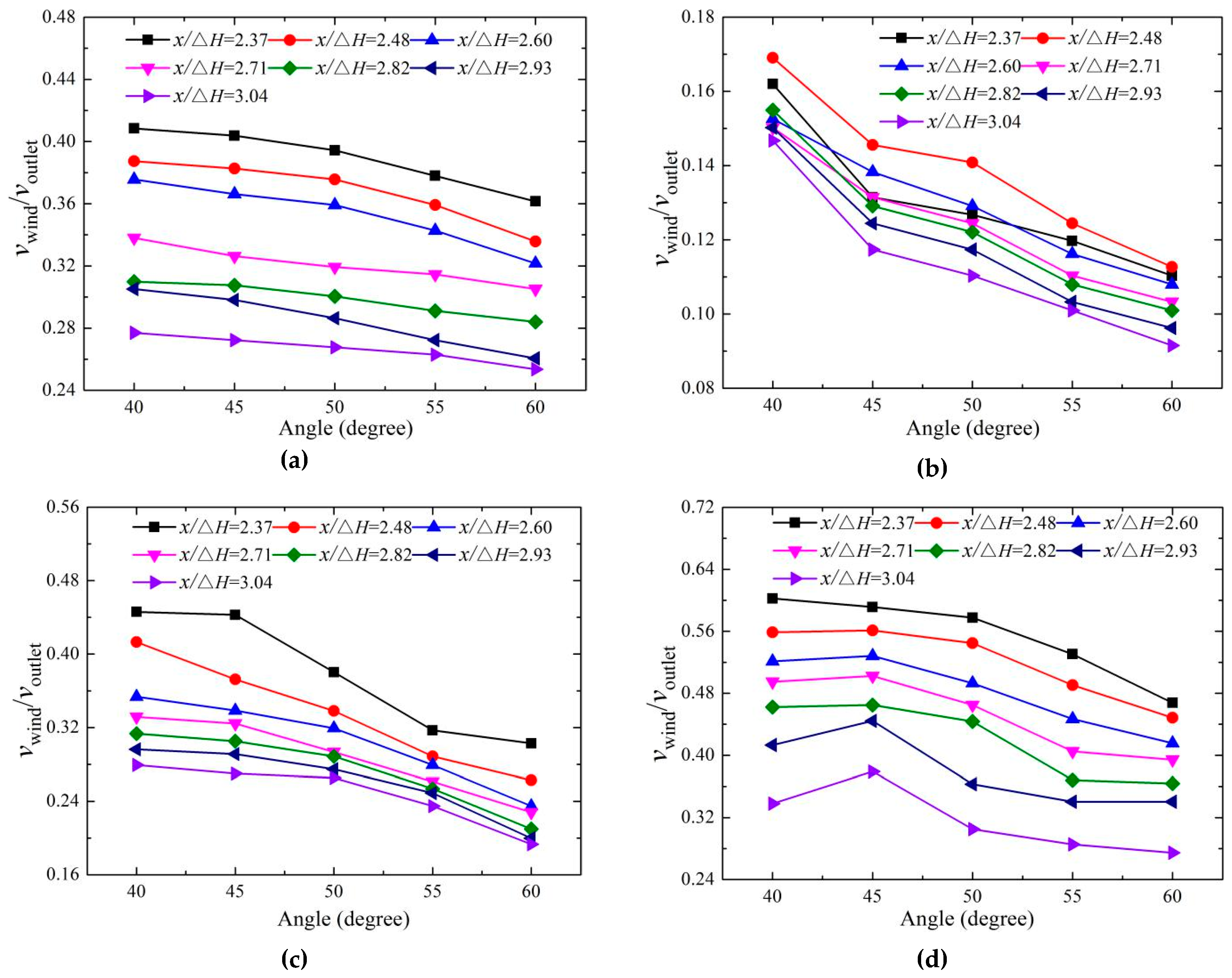
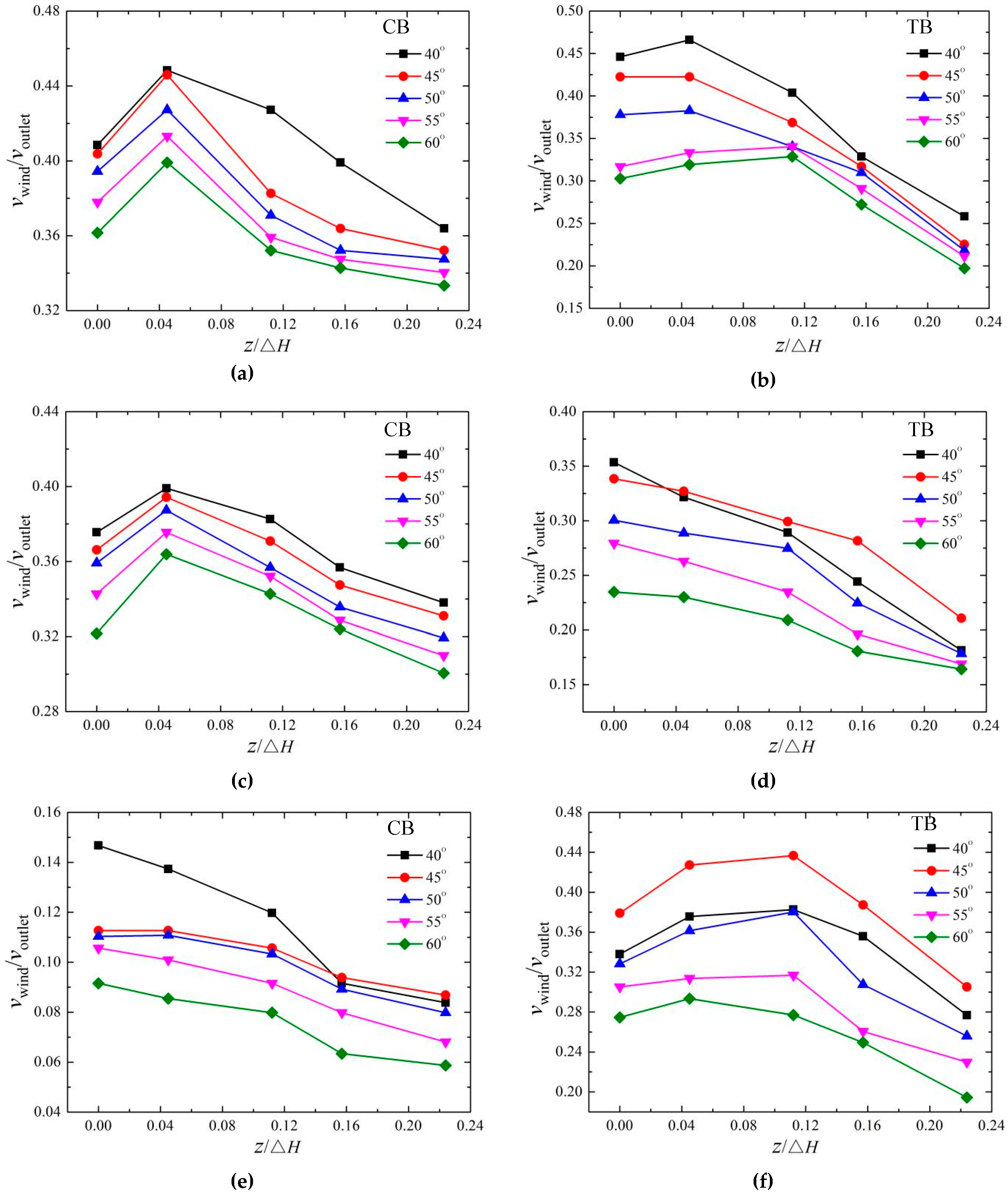
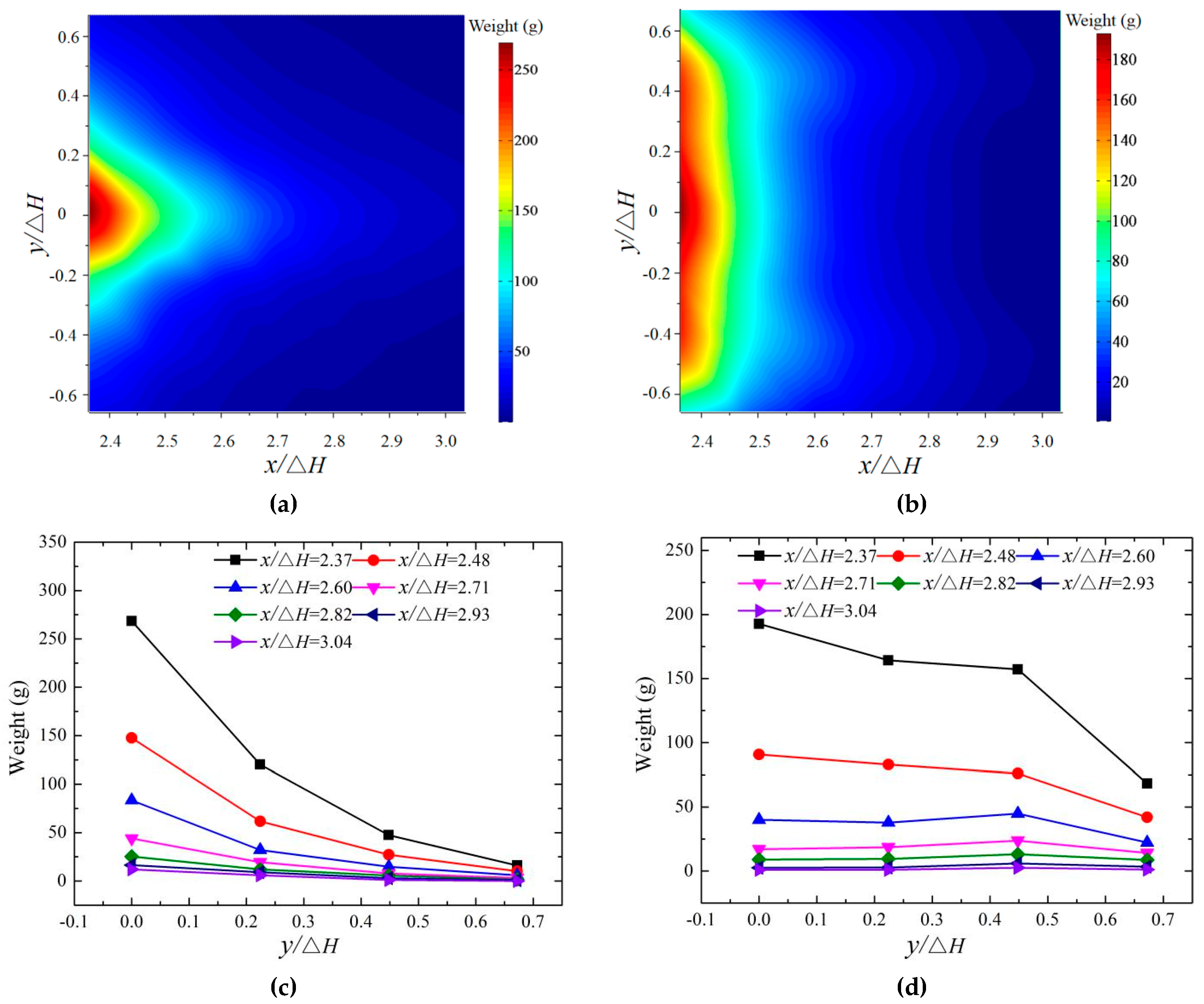
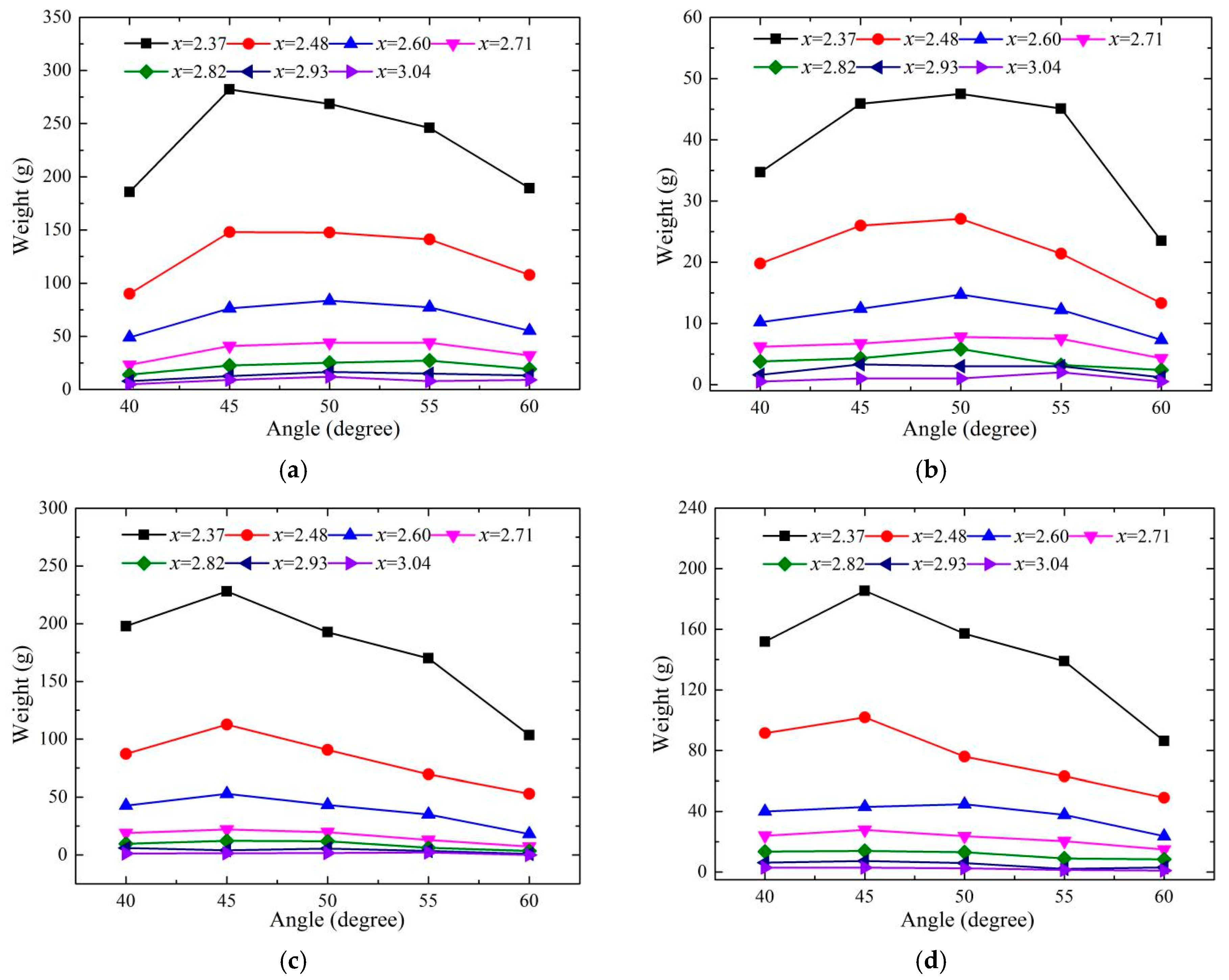
© 2019 by the authors. Licensee MDPI, Basel, Switzerland. This article is an open access article distributed under the terms and conditions of the Creative Commons Attribution (CC BY) license (http://creativecommons.org/licenses/by/4.0/).
Share and Cite
Lian, J.; He, J.; Gou, W.; Ran, D. Effects of Bucket Type and Angle on Downstream Nappe Wind Caused by a Turbulent Jet. Int. J. Environ. Res. Public Health 2019, 16, 1360. https://doi.org/10.3390/ijerph16081360
Lian J, He J, Gou W, Ran D. Effects of Bucket Type and Angle on Downstream Nappe Wind Caused by a Turbulent Jet. International Journal of Environmental Research and Public Health. 2019; 16(8):1360. https://doi.org/10.3390/ijerph16081360
Chicago/Turabian StyleLian, Jijian, Junling He, Wenjuan Gou, and Danjie Ran. 2019. "Effects of Bucket Type and Angle on Downstream Nappe Wind Caused by a Turbulent Jet" International Journal of Environmental Research and Public Health 16, no. 8: 1360. https://doi.org/10.3390/ijerph16081360
APA StyleLian, J., He, J., Gou, W., & Ran, D. (2019). Effects of Bucket Type and Angle on Downstream Nappe Wind Caused by a Turbulent Jet. International Journal of Environmental Research and Public Health, 16(8), 1360. https://doi.org/10.3390/ijerph16081360




